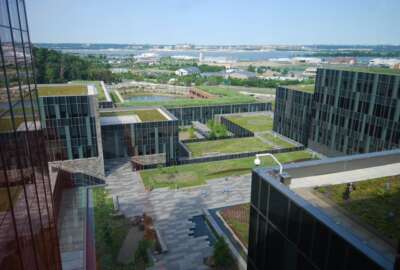Energy Dept. backs 17 green federal building upgrades as ‘preview’ of future spending
The Biden administration isn't waiting for Congress to pass the Build Back Better Act to reduce greenhouse gas emissions from federal buildings.
Best listening experience is on Chrome, Firefox or Safari. Subscribe to Federal Drive’s daily audio interviews on Apple Podcasts or PodcastOne.
The Biden administration isn’t waiting for Congress to pass the Build Back Better Act to reduce greenhouse gas emissions from federal buildings.
The General Services Administration is looking to accelerate the testing and adoption of sustainable technologies at federal buildings, and set a higher bar for sustainability standards in government construction projects.
The Energy Department, meanwhile, is spending $13 million to retrofit and upgrade 17 federal facilities to reduce emissions and energy costs.
GSA and the Energy Department announced these projects as a preview of the upgrades federal buildings would see under the nearly $2 trillion Build Back Better Act, which passed the House but has yet to pass the Senate.
Both agencies announced these projects last week, ahead of President Joe Biden’s executive order setting zero-emission goals for federal buildings and vehicles. But the projects will help the federal building portfolio become zero-emission by 2045.
Aside from energy efficiency, the agencies receiving funding are looking to make their facilities more resilient to climate change and ensure continuity of operations in the event of a major natural disaster.
Among the projects, the IRS is pursuing a near-net-zero energy efficiency and resiliency project that will allow the agency to operate for up to 30 days off the electric grid in the event of a power disruption.
Customs and Border Protection is getting funding to upgrade the Ramey Border Patrol Station and Headquarters facility in Puerto Rico, which faces severe hurricanes and tropical storms that can result in months-long power disruptions.
At the Pentagon, the Washington Headquarters Service, which provides administrative and management support to DoD components in the National Capital Region, is looking at cutting its energy usage and backup power capabilities that will allow off-grid operation during outages.
Energy Secretary Jennifer Granholm, at a Dec. 1 press conference, called the investments a “preview of what will be coming once the full Build Back Better agenda is adopted.”
“By outfitting federal buildings with technologies to reduce water and energy consumption and shrink carbon emissions, the federal government is leading by example and saving taxpayers money by lowering energy bills,” Granholm said.
GSA, meanwhile, is looking to accelerate the development of sustainable technology through its Green Proving Ground program, which has tested more than 80 next-generation building technologies since the program started in 2011.
GSA has deployed 23 technologies in federal buildings from the Green Proving Ground program, saving $16 million annually.
“New and innovative companies can test out their new products and services in federal buildings. By doing that, they are able to then scale up and sell in the private sector. We want federal buildings to be able to be a laboratory for these new innovations,” said GSA Administrator Robin Carnahan.
GSA and the Energy Department, in a request for information that closed Tuesday, asked for feedback on technologies such as high-efficiency solar panels and carbon-capture technologies that could help reduce greenhouse gas emissions from federal buildings.
Carnahan and Granholm announced the federal building upgrades at the New Carrollton Federal Building, which went through renovations from 2012 to 2016. These upgrades reduced the building’s energy consumption by 62% and cut water consumption in half.
Carnahan said upgrades at the New Carrollton Federal Building reduce greenhouse gas emission by 20,000 metric tons, the equivalent of what 2,400 homes produce in a year.
“It’s possible to do an upgrade of a 30-year-old building so that it can use a lot less energy and even create some of its own. It’s possible that federal and local officials can partner together to support communities and create great green jobs. It’s possible to get a big return for taxpayers and it’s absolutely possible to create a more sustainable future for our families. This is what we want to replicate,” Carnahan said.
Granholm called the New Carrollton investments a “quadruple win” that creates jobs, supports federal employees, helps the environment and saves money.
The renovations at the New Carrollton Federal Building save $2.5 million a year in energy costs and continue to pay dividends. Every $1 million spent on building projects, Granholm said, results in 20 years worth of direct and indirect employment.
The 1.2 million-square-foot New Carrollton Federal Building was built in 1994, and serves as a workplace for at least 4,400 federal workers, most of them IRS employees.
House Majority Leader Steny Hoyer (D-Md.) said these renovation projects will give federal employees a reason to return to the office, and will, in turn, help the local economy.
“It will make a difference for employees to come to work, which we need. We have too many people staying home. That’s not bad in and of itself, but we don’t have enough people to make our economy grow the way we want it,” Hoyer said.
Carnahan said the New Carrollton Federal Building is just one example of what the Biden administration is looking to do under the Build Back Better Plan, and urged Congress to pass the nearly $2 trillion spending package as soon as possible.
“We need to get started on more projects like this as soon as the bill can pass and get signed by the president. They’re going to be good-paying jobs. They’re going to be union jobs. They’re going to be all the things that we want in cutting-edge innovation. The president’s agenda… would be the largest investment in combating climate change in U.S. history,” Carnahan said.
Under the Build Back Better Act, GSA expects to invest more than $7 billion in low-carbon construction materials, emerging technologies, electric vehicles and charging stations. Carnahan said GSA is also working on upgrading its building and sustainability standards.
“It’s important because if the federal government raises the bar about what’s expected in building construction, then it makes it easier for local governments and the private sector to follow suit,” Carnahan said.
Copyright © 2025 Federal News Network. All rights reserved. This website is not intended for users located within the European Economic Area.
Jory Heckman is a reporter at Federal News Network covering U.S. Postal Service, IRS, big data and technology issues.
Follow @jheckmanWFED





